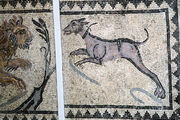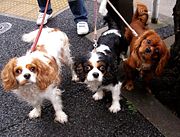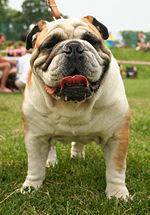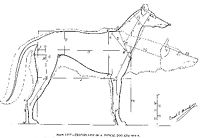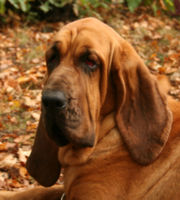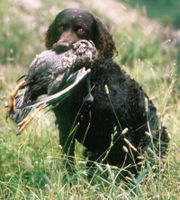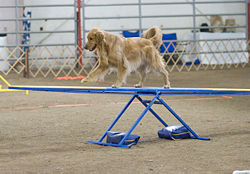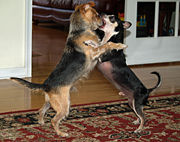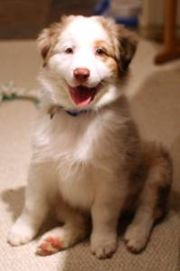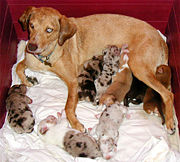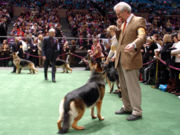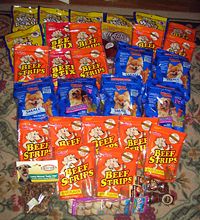Dog
2008/9 Schools Wikipedia Selection. Related subjects: Mammals
| Domestic dog Fossil range: Late Pleistocene – Recent |
||||||||||||||||||
|---|---|---|---|---|---|---|---|---|---|---|---|---|---|---|---|---|---|---|
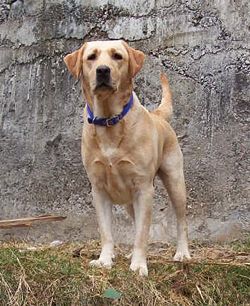 A Labrador Retriever
|
||||||||||||||||||
| Conservation status | ||||||||||||||||||
|
Domesticated
|
||||||||||||||||||
| Scientific classification | ||||||||||||||||||
|
||||||||||||||||||
| Trinomial name | ||||||||||||||||||
| Canis lupus familiaris (Linnaeus, 1758) |
The dog (Canis lupus familiaris) is a domesticated subspecies of the wolf, a mammal of the Canidae family of the order Carnivora. The term encompasses both feral and pet varieties and is also sometimes used to describe wild canids of other subspecies or species. The domestic dog has been one of the most widely kept working and companion animals in human history, as well as being a food source in some cultures. There are estimated to be 400 million dogs in the world.
The dog has developed into hundreds of varied breeds. Height measured to the withers ranges from a few inches in the Chihuahua to a few feet in the Irish Wolfhound; colour varies from white through grays (usually called blue) to black, and browns from light (tan) to dark ("red" or "chocolate") in a wide variation of patterns; and, coats can be very short to many centimeters long, from coarse hair to something akin to wool, straight or curly, or smooth.
Etymology and related terminology
The English word dog can be traced back to the Old English docga, a "powerful breed of canine". It is only attested since the early 16th century, and of uncertain further origin. The most probable source is Germanic *dukkōn, represented in Old English finger-docce 'finger-muscle', and some German and Old Norse words with meanings 'doll, small block, strong, round', which may have been applied to pups of a strong breed of dogs.
The English word hound is a cognate of German Hund, Dutch hond, common Scandinavian hund, Icelandic hundur which, though referring to a specific breed group in English, means "dog" in general in the other Germanic languages. Hound itself is derived from the Proto-Indo-European *kwon-, which is the direct root of the Greek κυων (kuōn) and the indirect root of the Latin canis through the variant form *kani-.
In breeding circles, a male canine is referred to as a dog, while a female canine is called a bitch. The father of a litter is called the sire, and the mother of a litter is called the dam. Offspring are generally called pups or puppies until they are about a year old. A group of offspring is a litter. The process of birth is whelping. Many terms are used for dogs that are not purebred.
Taxonomy
The English word dog, in common usage, refers to the domestic pet dog, Canis lupus familiaris. The species was originally classified as Canis familiaris and "Canis familiarus domesticus" by Linnaeus in 1758. In 1993, dogs were reclassified as a subspecies of the gray wolf, Canis lupus, by the Smithsonian Institution and the American Society of Mammalogists. "Dog" is sometimes used to refer collectively to any mammal belonging to the family Canidae (as in "the dog family"), such as wolves, foxes, and coyotes. Some members of the family have "dog" in their common names, such as the Raccoon Dog and the African Wild Dog. A few animals have "dog" in their common names but are not canids, such as the prairie dog.
Origin and evolution
Origins
Based on DNA evidence, the wolf ancestors of modern dogs diverged from other wolves about 100,000 years ago, and dogs were domesticated from those wolf ancestors about 15,000 years ago. This date would make dogs the first species to be domesticated by humans.
Evidence suggests that dogs were first domesticated in East Asia, possibly China, and some of the peoples who entered North America took dogs with them from Asia.
As humans migrated around the planet, a variety of dog forms migrated with them. The agricultural revolution and subsequent urban revolution led to an increase in the dog population and a demand for specialization. These circumstances would provide the opportunity for selective breeding to create specialized working dogs and pets.
Ancestry and history of domestication
Molecular systematics indicate that the domestic dog (Canis lupus familiaris) descends from one or more populations of wild wolves (Canis lupus). As reflected in the nomenclature, dogs are descended from the wolf and are able to interbreed with wolves.
The relationship between human and canine has deep roots. Converging archaeological and genetic evidence indicate a time of domestication in the late Upper Paleolithic close to the Pleistocene/ Holocene boundary, between 17,000 and 14,000 years ago. Fossil bone morphologies and genetic analysis of current and ancient dog and wolf populations have not yet been able to conclusively determine whether all dogs descend from a single domestication event, or whether dogs were domesticated independently in more than one location. Domesticated dogs may have interbred with local populations of wild wolves on several occasions (a process known in genetics as introgression).
The earliest dog fossils, two crania from Russia and a mandible from Germany, date from 13,000 to 17,000 years ago. Their likely ancestor is the large northern Holarctic wolf, Canis lupus lupus. Remains of smaller dogs from Mesolithic ( Natufian) cave deposits in the Middle East, dated to around 12,000 years ago, have been interpreted as descendants of a lighter Southwest Asian wolf, Canis lupus Arabs. Rock art and skeletal remains indicate that by 14,000 years ago, dogs were present from North Africa across Eurasia to North America. Dog burials at the Mesolithic cemetery of Svaerdborg in Denmark suggest that in ancient Europe dogs were valued companions.
Genetic analyses have so far yielded divergent results. Vilà, Savolainen, and colleagues (1997) concluded that the ancestors of dogs split off from other wolves between 75,000 and 135,000 years ago, while a subsequent analysis by Savolainen et al. (2002) indicated a "common origin from a single gene pool for all dog populations" between 40,000 and 15,000 years ago in East Asia. Verginelli et al. (2005), however, suggest both sets of dates must be reevaluated in light of recent findings showing that poorly calibrated molecular clocks have systematically overestimated the age of geologically recent events. On balance, and in agreement with the archaeological evidence, 15,000 years ago is the most likely time for the wolf-dog divergence.
The Soviets have attempted to domesticate the fox, mentioned in the article Tame Silver Fox, and were able to do so in just nine generations, or less than a human lifetime. This also resulted in other changes, including colour, which became black, white, or black and white. They also developed year-round breeding ability, curled-up tails, and droopy ears.
The rapidity of this change has suggested to researchers a scenario of the origin of the domestic dog. Primitive people lived on the edge of survival which involved occasional food shortages, and would not have taken wolf pups and made pets of them. However, wolves would raid garbage dumps near human habitations. Wolves have a flight distance which they keep between themselves and a threatening creature. When a dump was approached by humans, some wolves would run a greater distance from the dump than others. Those that ran the shortest distance would return first, and obtain the greatest amount of food.
This set up a selective breeding situation that resulted in a strain of wolves having shorter and shorter flight distances, until they were eventually comfortable near humans, having domesticated themselves, so to speak. At that point, they were tolerated by humans, so long as they were also useful, in such ways as catching rats or driving away other predators. In time, other uses, such as hunting, were found for them. The Farm Fox Experiment Evolution of Dogs
Development of dog breeds
There are numerous dog breeds, with over 800 being recognized by various kennel clubs worldwide. Many dogs, especially outside the United States of America and Western Europe, belong to no recognized breed. A few basic breed types have evolved gradually during the domesticated dog's relationship with humans over the last 10,000 or more years, but all modern breeds are of relatively recent derivation. Many of these are the product of a deliberate process of artificial selection. Because of this, some breeds are highly specialized, and there is extraordinary morphological diversity across different breeds. Despite these differences, dogs are able to distinguish dogs from other kinds of animal.
The definition of a dog breed is a matter of some controversy. Depending on the size of the original founding population, closed gene pool breeds can have problems with inbreeding, specifically due to the founder effect. Dog breeders are increasingly aware of the importance of population genetics and of maintaining diverse gene pools. Health testing and new DNA tests can help avoid problems, by providing a replacement for natural selection. Without selection, inbreeding and closed gene pools can increase the risk of severe health or behavioural problems. Some organizations define a breed more loosely, such that an individual may be considered of one breed as long as 75% of its parentage is of that breed. These considerations affect both pets and the show dogs entered in dog shows. Even prize-winning purebred dogs sometimes possess crippling genetic defects due to founder effect or inbreeding. These problems are not limited to purebred dogs and can affect cross-breed populations. The behavior and appearance of a dog of a particular breed can be predicted to a degree, while mixed-breed dogs show a broader range of innovative appearance and behaviour.
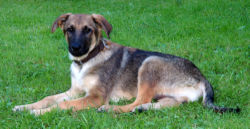
Mixed-breed dogs or Mongrels (also called "mutts") are dogs that do not belong to specific breeds, being mixtures more than two in variant percentages. Mixed breed dogs and purebred dogs are both suitable as companions, pets, working dogs, or competitors in dog sports. Sometimes different breed dogs are deliberately bred, to create cross-breeds such as the Cockapoo, a mixture of Cocker Spaniel and Miniature Poodle. Such deliberate crosses may display some degree of hybrid vigor and other desirable traits, but may or may not inherit any of the desired traits of their parents, such as temperament or a particular colour or coat. Without genetic testing of the parents, the crosses can end up inheriting genetic defects that occur in both parental breeds.
A breed is a group of animals that possesses a set of inherited characteristics that distinguishes it from other animals within the same species. Deliberately crossing two or more breeds is also a manner of establishing new breeds, but it is only a breed when offspring will reliably demonstrate that particular set of characteristics and qualities.
Breed popularity
Breed popularity varies widely over time and in different parts of the world and different segments of the population. Counting by American Kennel Club (AKC) registration (not by licensing registration or by United Kennel Club (UKC) registration, which could present different statistics), the Labrador Retriever has been the United States's most commonly registered breed of dog since 1991. However, even within parts of the United States, popularity varies; for example, in 2005 the most-registered breed in New York City was the Poodle while the Yorkshire Terrier was the second-most-registered breed in Houston. However, animal shelters in many parts of the United States report that the most-commonly available dog for adoption is the American Pit Bull Terrier or pit bull-type mixes, making up as much as 20% of dogs available for adoption, none of which would be registered with the AKC. Two decades ago, in 1983, the AKC's top two registered breeds were the American Cocker Spaniel and the Poodle.
In the United Kingdom, The Kennel Club reports that the most-registered breed from at least 1999 to 2005 was the Labrador Retriever. It rounds out the top three for 1999 to 2005 with the German Shepherd Dog, also popular in the US, and the English Cocker Spaniel , which is no longer in the top ten in the US. In the UK, a national dog adoption and rescue service indicates that the most common breed appearing in shelters is the Greyhound followed by the Staffordshire Bull Terrier.
Physical characteristics
Modern dog breeds show more variation in size, appearance, and behaviour than any other domestic animal. Within the range of extremes, dogs generally share attributes with their wild ancestors, the wolves. Dogs are predators and scavengers, possessing sharp teeth and strong jaws for attacking, holding, and tearing their food. Although selective breeding has changed the appearance of many breeds, all dogs retain basic traits from their distant ancestors. Like many other predatory mammals, the dog has powerful muscles, fused wristbones, a cardiovascular system that supports both sprinting and endurance, and teeth for catching and tearing. Unlike humans which are plantigrade, dogs are digitigrade.
Differences from other canids
Compared to equally sized wolves, dogs tend to have 20% smaller skulls and 10% smaller brains, as well as proportionately smaller teeth than other canid species. Dogs require fewer calories to function than wolves. Their diet of human refuse in antiquity made the large brains and jaw muscles needed for hunting unnecessary. It is thought by certain experts that the dog's limp ears are a result of atrophy of the jaw muscles. The skin of domestic dogs tends to be thicker than that of wolves, with some Inuit tribes favouring the former for use as clothing due to its greater resistance to wear and tear in harsh weather. Unlike wolves, but like coyotes, domestic dogs have sweat glands on their paw pads. The paws of a dog are half the size of those of a wolf, and their tails tend to curl upwards, another trait not found in wolves.
Sight
Like most mammals, dogs are dichromats and have colour vision equivalent to red-green colour blindness in humans.
Different breeds of dogs have different eye shapes and dimensions, and they also have different retina configurations. Dogs with long noses have a "visual streak" which runs across the width of the retina and gives them a very wide field of excellent vision, while those with short noses have an "area centralis" — a central patch with up to three times the density of nerve endings as the visual streak — giving them detailed sight much more like a human's.
Some breeds, particularly the sighthounds, have a field of vision up to 270° (compared to 180° for humans), although broad-headed breeds with short noses have a much narrower field of vision, as low as 180°.
Hearing
Dogs detect sounds as low as the 16 to 20 Hz frequency range (compared to 20 to 70 Hz for humans) and above 45 kHz (compared to 13 to 20 kHz for humans), and in addition have a degree of ear mobility that helps them to rapidly pinpoint the exact location of a sound. Eighteen or more muscles can tilt, rotate and raise or lower a dog's ear. Additionally, a dog can identify a sound's location much faster than a human can, as well as hear sounds up to four times the distance that humans are able to. Those with more natural ear shapes, like those of wild canids like the fox, generally hear better than those with the floppier ears of many domesticated species.
Smell
Dogs have nearly 220 million smell-sensitive cells over an area about the size of a pocket handkerchief (compared to 5 million over an area the size of a postage stamp for humans). Some breeds have been selectively bred for excellence in detecting scents, even compared to their canine brethren. What information a dog actually detects when he is scenting is not perfectly understood; although once a matter of debate, it now seems to be well established that dogs can distinguish two different types of scents: an air scent from some person or thing that has recently passed by, and a ground scent that remains detectable for a much longer period. The characteristics and behaviour of these two types of scent trail would seem, after some thought, to be quite different, the air scent being intermittent but perhaps less obscured by competing scents, whereas the ground scent would be relatively permanent with respect to careful and repetitive search by the dog, but would seem to be much more contaminated with other scents. In any event, it is established by those who train tracking dogs that it is impossible to teach the dog how to track any better than it does naturally; the object instead is to motivate it properly, and teach it to maintain focus on a single track and ignore any others that might otherwise seem of greater interest to an untrained dog. An intensive search for a scent, for instance searching a ship for contraband, can actually be very fatiguing for a dog, and the dog must be motivated to continue this hard work for a long period of time.
Coat colour
Domestic dogs often display the remnants of counter-shading, a common natural camouflage pattern. The general theory of countershading is that an animal that is lit from above will appear lighter on its upper half and darker on its lower half where it will usually be in its own shade. This is a pattern that predators can learn to watch for. A countershaded animal will have dark coloring on its upper surfaces and light coloring below. This reduces the general visibility of the animal. One reminder of this pattern is that many breeds will have the occasional "blaze", stripe, or "star" of white fur on their chest or undersides.
Tail
There are many different shapes for dog tails: straight, straight up, sickle, curled, cork-screw. In some breeds, the tail is traditionally docked to avoid injuries (especially for hunting dogs). It can happen that some puppies are born with a short tail or no tail in some breeds.
Sprint metabolism
Dogs can generate large amounts of energy for a short period of time. A dog's heart and lungs are oversized relative to its body and its normal everyday needs. A dog also has relatively more red blood cells than a human. Most of the time the dog will keep the extra red blood cells stored in its spleen. When the animal enters into a situation where its full metabolism is required, such as play, catching game, or fighting other dogs, the extra cells are released into the bloodstream. The "oversized" heart and lungs will now be running at full capacity, and the animal will have an enhanced ability to engage in aerobic activity. This activity will produce internal heating. Dogs, being covered in fur, are limited in their ability to cool down. After a short time the animal must either cease its athletic activity or risk harming itself from overheating. One can easily observe this pattern of intense activity followed by rest periods in puppies. During the rest phase the spleen collects red blood cells and the animal may pant to cool down.
Behaviour and intelligence
Dogs are very social animals, but their personality and behaviour vary with breed as well as how they are treated by their owners and others who come in contact with them. It is not uncommon for dogs to attack humans and other animals; however, this is usually because of lack of care or improper upbringing by its owner.
Differences from other canids
Dogs tend to be poorer than wolves and coyotes at observational learning, being more responsive to instrumental conditioning. Feral dogs show little of the complex social structure or dominance hierarchy present in wolf packs. For dogs, other members of their kind are of no help in locating food items, and are more like competitors. Feral dogs are primarily scavengers, with studies showing that unlike their wild cousins, they are poor ungulate hunters, having little impact on wildlife populations where they are sympatric. Free ranging pet dogs however are more prone to predatory behaviour toward wild animals. Feral dogs have been reported to be effective hunters of reptiles in the Galapagos islands.
Intelligence
Dogs are valued for their intelligence. This intelligence is expressed differently with different breeds and individuals, however. For example, Border Collies are noted for their ability to learn commands, while other breeds may not be so motivated towards obedience, but instead show their cleverness in devising ways to steal food or escape from a yard. Being highly adaptable animals themselves, dogs have learned to do many jobs as required by humans over the generations. Dogs are employed in various roles across the globe, proving invaluable assets in areas such as search-and-rescue; law enforcement (including attack dogs, sniffer dogs and tracking dogs); guards for livestock, people or property; herding; Arctic exploration sled-pullers; guiding the blind and acting as a pair of ears for the deaf; assisting with hunting, and a great many other roles which they may be trained to assume. Most dogs rarely have to deal with complex tasks and are unlikely to learn relatively complicated activities (such as opening doors) unaided. Some dogs (such as guide dogs for the visually impaired) are specially trained to recognize and avoid dangerous situations.
Evaluation of a dog's intelligence
The meaning of "intelligence" in general, not only in reference to dogs, is hard to define. Some tests measure problem-solving abilities and others test the ability to learn in comparison to others of the same age. Defining it for dogs is just as difficult. It is likely that dogs do not have the ability to premeditate an action to solve a problem.
For example, the ability to learn quickly could be a sign of intelligence. Conversely it could be interpreted as a sign of a desire to please. In contrast, some dogs who do not learn very quickly may have other talents. An example is breeds that are not particularly interested in pleasing their owners, such as Siberian Huskies. Huskies are often fascinated with the myriad of possibilities for escaping from yards, catching small animals, and often figuring out on their own numerous inventive ways of doing both.
Assistance dogs are also required to be obedient at all times. This means they must learn a tremendous number of commands, understand how to act in a large variety of situations, and recognize threats to their human companion, some of which they might never before have encountered.
Many owners of livestock guardian breeds believe that breeds like the Great Pyrenees or the Kuvasz are not easily trained because their stubborn nature prevents them from seeing the point of such commands as “sit” or “down”. Hounds may also suffer from this type of ranking. These dogs are bred to have more of a "pack" mentality with other dogs and less reliance on a master's direct commands. While they may not have the same kind of intelligence as a Border Collie, they were not bred to learn and obey commands quickly, but to think for themselves while trailing game.
Human relationships
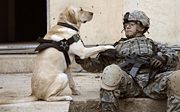
Dogs are highly social animals. This can account for their trainability, playfulness, and ability to fit into human households and social situations. These attributes have earned dogs a unique position in the realm of interspecies relationships despite being one of the most effective, voracious, and potentially dangerous predators. Dogs and humans at times co-operate in some of the most effective hunting in the animal world; in that context, dogs are superpredators.
The loyalty and devotion that dogs demonstrate as part of their natural instincts as pack animals closely mimics the human idea of love and friendship, leading many dog owners to view their pets as full-fledged family members. Conversely, dogs seem to view their human companions as members of their pack, and make few, if any, distinctions between their owners and fellow dogs. Dogs fill a variety of roles in human society and are often trained as working dogs. For dogs that do not have traditional jobs, a wide range of dog sports provide the opportunity to exhibit their natural skills. In many countries, the most common and perhaps most important role of dogs is as companions.
Dogs have lived and worked with humans in so many roles that their loyalty has earned them the unique sobriquet "man's best friend". However, some cultures consider dogs to be unclean. In some parts of the world, dogs are raised as livestock to produce dog meat for human consumption. In many places, consumption of dog meat is discouraged by social convention or cultural taboo.
Dog communication
Reproduction
Differences from other canids
Unlike most other canids, dogs are not monogamous, and breeding in feral packs is not restricted to a dominant alpha pair (despite common belief, such things also occur in wolf packs). Male dogs are unusual among canids by the fact that they mostly play no role in raising their puppies, and do not kill the young of other females to increase their own reproductive success. Dogs differ from wolves and most other large canid species by the fact that they do not regurgitate food for their young, nor the young of other dogs in the same territory. However, this difference was not observed in all domestic dogs. Regurgitating of food for the young as well as care for the young by the males has been observed in domestic dogs, dingos as well as in other feral or semi-feral dogs. Regurgitating of food by the females and direct choosing of only one mate has been observed even in those semi-feral dogs of direct domestic dog ancestry. So it is sometimes suggested, that the absence of this behaviour was unknowingly caused by artificial selection by humans.
Life cycle
In domestic dogs, sexual maturity ( puberty) begins to happen around age 6 to 12 months for both males and females, although this can be delayed until up to two years old for some large breeds. Adolescence for most domestic dogs is around 12 to 15 months, beyond which they are for the most part more adult than puppy. As with other domesticated species, domestication has selectively bred for higher libido and earlier and more frequent breeding cycles in dogs, than in their wild ancestors. Dogs remain reproductively active until old age.
Most female dogs have their first estrous cycle between 6 and 12 months, although some larger breeds delay until as late as 2 years. Females experience estrous cycles biannually, during which her body prepares for pregnancy, and at the peak she will come into estrus, during which time she will be mentally and physically receptive to copulation.
Dogs bear their litters roughly 56 to 72 days after fertilization, although the length of gestation can vary. An average litter consists of about six puppies, though this number may vary widely based on the breed of dog. Toy dogs generally produce from one to four puppies in each litter, while much larger breeds may average as many as 12 pups in each litter.
Spaying and neutering
Neutering (spaying females and castrating males) refers to the sterilization of animals, usually by removal of the male's testicles or the female's ovaries and uterus, in order to eliminate the ability to procreate, and reduce sex drive. Neutering has also been known to reduce aggression in male dogs, but has been shown to occasionally increase aggression in female dogs.
Animal control agencies in the United States and the ASPCA advise that dogs not intended for further breeding should be neutered so that they do not have undesired puppies.
Because of the overpopulation of dogs in some countries, puppies born to strays or as the result of accidental breedings often end up being killed in animal shelters. Neutering can also decrease or eliminate the risk of hormone-driven diseases such as mammary cancer, as well as undesired hormone-driven behaviors. However, certain medical problems are more likely after neutering, such as urinary incontinence in females and prostate cancer in males. The hormonal changes involved with sterilization are likely to somewhat change the animal's personality, however, and some object to neutering as the sterilization could be carried out without the excision of organs.
It is not essential for a female dog to either experience a heat cycle or have puppies before spaying, and likewise, a male dog does not need the experience of mating before castration.
Female cats and dogs are seven times more likely to develop mammary tumors if they are not spayed before their first heat cycle. Dog food containing soybeans or soybean fractions have been found to contain phytoestrogens in levels that could have biological effects when ingested longterm.
Gender-preservative surgeries such as vasectomy and tubal ligation are possible, but do not appear to be popular due to the continuation of gender-specific behaviors and disease risks.
Overpopulation
United States
According to the Humane Society of the United States, 3–4 million dogs and cats are put down each year in the United States and many more are confined to cages in shelters because there are many more animals than there are homes. Spaying or castrating dogs helps keep overpopulation down. Local humane societies, SPCAs and other animal protection organizations urge people to neuter their pets and to adopt animals from shelters instead of purchasing them. Several notable public figures have spoken out against animal over population, including Bob Barker. On his game show, The Price Is Right, Barker stressed the problem at the end of every episode, saying: "Help control the pet population. Have your pets spayed or neutered." The current host, Drew Carey, makes a similar plea at the conclusion of each episode.
Working, utility and assistance dogs
There are several types of working dogs:

- Assistance dogs which help the seeing and hearing-impaired. Others are trained to help those with epilepsy and psychiatric disorders, by detecting the onset of the condition so they can seek help. The typical assistance dog is a sociable breed such as a Labrador Retriever.
- The detection dog, which is a dog trained to and works at using its senses (almost always the sense of smell) to detect substances such as explosives or illegal drugs.
- Guard dogs are trained for personal protection, or to protect property. These are commonly Doberman Pinschers, German Shepherds and Rottweilers as well as dogs of other breeds that have protection instinct.
- Herding dogs can be trained to help the herder to move the herded animals, such as sheep. Australian Cattle Dog, Border Collie, and German Shepherd are common herding breeds.
- Hunting dogs can be trained to assist the hunter. Terriers and retrievers are hunting breeds.
- Police dogs, typically German Shepherds, are trained to assist law enforcement officers.
- Search and Rescue dogs also known as SAR dogs, are specially trained to search for missing humans. The archetypal breed is the St. Bernard. Nowadays, many dogs of other breeds, such as German Shepherd and Doberman Pinscher are trained to perform this task.
- Rescue at sea dogs - Newfoundland
- Therapy dogs, with friendly and gentle temperaments, trained to provide comfort and affection to hospitalized and institutionalized patients.
- The war dog, used by the military to detect mines and enemy soldiers.
- Livestock Guardian dog, are used to protect livestock in the range against predators and theft. Maremma Sheepdog and Anatolian Shepherd Dog are typical livestock guardians.
Show and sport (competition) dogs
Owners of dogs often enter them in competitions, whether show (breed conformation shows) or sports, including dog racing & dog sledding. The winners garner much prestige and prize money. These dogs are often bred specifically for competition, which may not be entirely beneficial for the breeds due to the magnification of hereditary defects.
- Dog agility is a sport in which dogs complete a timed obstacle course.
- Dogsled racing is a winter sport where a team of dogs, usually high performance mixed breed dogs called Alaskan Huskies or Eurohounds, pull a sled and driver (called a musher). The Iditarod Trail Sled Dog Race is perhaps the most famous of these races. Dog sledding is an ancient form of transportation and still a very effective way of moving freight across this type of terrain.
- Dog racing, almost always Greyhounds, involves dogs racing at betting tracks in a sport not unlike horseracing, reaching speeds of 40 miles per hour. Elsewhere, Dachshunds are often raced, as a humorous sidelight in charity events.
- Dog fighting and dog baiting are blood sports involving dogs. They are illegal in most jurisdictions, but are still performed underground. In some areas, the illegal practice is thriving.
- Conformation showing is a sport in which purebred dogs are shown and evaluated for how closely they match the ideal characteristics of the breed. The Westminster Kennel Club Dog Show is one of the most famous of this type of competition.
Dog health
Morbidity (illness)
Dogs are susceptible to various diseases, ailments, and poisons, some of which affect humans in the same way, others of which are unique to dogs. Dogs, like all mammals, are also susceptible to heat exhaustion when dealing with high levels of humidity and/or extreme temperatures.
Diseases
Infectious diseases commonly associated with dogs include rabies (hydrophobia), canine parvovirus, and canine distemper. Inherited diseases of dogs can include a wide range from elbow or hip dysplasia and medial patellar luxation to epilepsy and pulmonic stenosis. Canines can get just about anything a human can get (excluding many infections which are species specific) like hypothyroidism, cancer, dental disease, heart disease, etc.
Two serious medical conditions affecting dogs are pyometra, affecting unspayed females of all types and ages, and bloat, which affects the larger breeds or deep chested dogs. Both of these are acute conditions, and can kill rapidly; owners of dogs which may be at risk should learn about such conditions as part of good animal care.
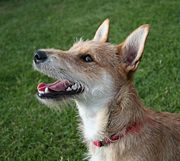
Parasites
Common external parasites are various species of fleas, ticks, and mites. Internal parasites include hookworms, tapeworms, roundworms, and heartworms. See also CVBD (Canine Vector-Borne Diseases).
Common physical disorders
Some breeds of dogs are also prone to certain genetic ailments, such as hip dysplasia, luxating patellas, cleft palate, blindness, or deafness. Dogs are also susceptible to the same ailments that humans are, including diabetes, epilepsy, cancer, and arthritis. Gastric torsion and bloat is a dangerous problem in some large-chested breeds.
Mortality (lifespan and causes of death)
The typical lifespan of dogs varies widely among breeds. Based on questionnaire surveys of owners in the UK, Denmark, USA, and Canada, the median longevity of most dog breeds is between 10 and 13 years. The breed with the dubious distinction of the shortest lifespan (among breeds for which there is a questionnaire survey with a reasonable sample size) is the Dogue de Bordeaux with a median longevity of about 5.2 years, but several breeds, including Miniature Bull Terrier, Bulldog, Nova Scotia Duck Tolling Retriever, Bloodhound, Irish Wolfhound, Greater Swiss Mountain Dog, Great Dane, and Mastiff, are nearly as short-lived, with median longevities between 6 and 7 years. On the other end of the spectrum, the longest-lived breeds, including Toy Poodle, Border Terrier, Miniature Dachshund, Miniature Poodle, and Tibetan Spaniel, have median longevities between 14 and 15 years. The median longevity of mixed breed dogs (average of all sizes) is one or more years longer than that of purebred dogs (all breeds averaged). As a rule of thumb, small breeds are longer-lived than large breeds, but some of the longest lived large breeds have median longevities nearly as long as those of the shortest lived small breeds, and some of the breeds with the shortest longevities are medium-sized.
"Median longevity" refers to the age at which half the dogs in a population have died and half are still alive. Individual dogs, even in breeds with low median longevities, may live well beyond the median. The dog widely reported to be the longest-lived on record is " Bluey," purportedly born in 1910 in Australia. He died in 1939 at the age of 29.5 years. Bluey is usually identified as an Australian Cattle Dog, but the first Australian Cattle Dog breed standard was written in 1902, only eight years before Bluey's birth. It is unclear how closely Bluey was related to the breed as it exists today. The Bluey record is anecdotal and unverified. The longest verified records are of dogs living to 24 years.
Predation
In some areas where dogs and wolves are sympatric, dogs can be a major food source for wolves. Reports from Croatia indicate that dogs are killed more frequently than sheep. Wolves in Russia apparently limit feral dog populations. In Wisconsin, more compensation has been paid for dog losses than livestock. Some wolf pairs have been reported to predate on dogs by having one wolf lure the dog out into heavy brush where the second animal waits in ambush. In some instances, wolves have displayed an uncharacteristic fearlessness of humans and buildings when attacking dogs, to an extent where they have to be beaten off or killed. Coyotes have also been known to attack dogs. Approximately 3 to 5 pets attacked by coyotes, mostly dogs, are brought into the Animal Urgent Care hospital of South Orange County each week.
Big cats have been recorded to kill dogs. Leopards in particular are known to have a prediliction for dogs, and have been recorded to kill and consume them regardless of the dog's size or ferocity. Unlike sympatric leopards, tigers in India seldom prey on dogs, though in Manchuria, Indochina, Indonesia and Malaysia, tigers are reputed to kill dogs with the same vigour as leopards.
Striped hyenas are major predators of village dogs in Turkmenistan, India and the Caucasus.
Diet
Nutrition
There is some debate as to whether domestic dogs should be classified as omnivores or carnivores, by diet. The classification in the Order Carnivora does not necessarily mean that a dog's diet must be restricted to meat; unlike an obligate carnivore, such as the cat family with its shorter small intestine, a dog is neither dependent on meat-specific protein nor a very high level of protein in order to fulfill its basic dietary requirements. Dogs are able to healthily digest a variety of foods including vegetables and grains, and in fact dogs can consume a large proportion of these in their diet. Wild canines not only eat available plants to obtain essential amino acids, but also obtain nutrients from vegetable matter from the stomach and intestinal contents of their herbivorous prey, which they usually consume. Domestic dogs can survive healthily on a reasonable and carefully designed vegetarian diet, particularly if eggs and milk products are included. Some sources suggest that a dog fed on a strict vegetarian diet without L-carnitine may develop dilated cardiomyopathy, however, L-carnitine is found in many nuts, seeds, beans, vegetables, fruits and whole grains. In the wild, dogs can survive on a vegetarian diet when animal prey is not available. Observation of extremely stressful conditions such as the Iditarod Trail Sled Dog Race, and scientific studies of similar conditions has shown that high-protein (approximately 40%) diets including meat help prevent damage to muscle tissue in dogs and some other mammals. This level of protein corresponds to the percentage of protein found in the wild dog's diet when prey is abundant; higher levels of protein seem to confer no added benefit.
Dogs frequently eat grass, which is a harmless activity. Explanations abound, but rationales such as that it neutralizes acid, or that dogs eat grass to induce vomiting to remove unwanted substances from their stomachs, are at best educated guesses. Dogs do vomit more readily than humans, as part of their typical feeding behavior of gulping down food then regurgitating indigestible material such as bones and fur. This behaviour is typical of pack feeding in the wild, where the most important thing is to get as much of the kill as possible before others consume it all. Individual domestic dogs, however, may be very "picky" eaters, in the absence of this social pressure. Dogs may also appear to eat grass when they are just running the blades through their mouth to gather information. Their sense of smell and taste may act together to detect if other animals have walked through their area or urinated on the grass.
Dangerous substances
- Human food. Some foods commonly enjoyed by humans are dangerous to dogs, including chocolate ( Theobromine poisoning), onions, grapes and raisins, some types of gum, certain sweeteners and Macadamia nuts. The only known dangerous substance in chocolate is cocoa, so the danger of white chocolate is uncertain. The acute danger from grapes and raisins was discovered around 2000, and has slowly been publicized since then. The cause is not known. Small quantities will induce acute renal failure. Sultanas and currants may also be dangerous. Alcoholic beverages pose comparable hazards to dogs as they do to humans, but due to low body weight and lack of alcohol tolerance they are toxic in much smaller portions.
- Plants. Plants such as caladium, dieffenbachia and philodendron will cause throat irritations that will burn the throat going down as well as coming up. Hops are particularly dangerous and even small quantities can lead to malignant hyperthermia. Amaryllis, daffodil, english ivy, iris, and tulip (especially the bulbs) cause gastric irritation and sometimes central nervous system excitement followed by coma, and, in severe cases, even death. Ingesting foxglove, lily of the valley, larkspur and oleander can be life threatening because the cardiovascular system is affected. Yew is very dangerous because it affects the nervous system. Immediate veterinary treatment is required for dogs that ingest these.
- Household poisons. Many household cleaners such as ammonia, bleach, disinfectants, drain cleaner, soaps, detergents, and other cleaners, mothballs and matches are dangerous to dogs, as are cosmetics such as deodorants, hair coloring, nail polish and remover, home permanent lotion, and suntan lotion. Dogs find some poisons attractive, such as antifreeze (automotive coolant), slug and snail bait, insect bait, and rodent poisons. Antifreeze is insidious to dogs, either puddled or even partly cleaned residue, because of its sweet taste. A dog may pick up antifreeze on its fur and then lick it off.
- Animal feces. Dogs occasionally eat their own feces, or the feces of other dogs and other species if available, such as cats, deer, cows, or horses. This is known as coprophagia. Some dogs develop preferences for one type over another. There is no definitive reason known, although boredom, hunger, and nutritional needs have been suggested. Eating cat feces is common, possibly because of the high protein content of cat food. Dogs eating cat feces from a litter box may lead to Toxoplasmosis. Dogs seem to have different preferences in relation to eating feces. Some are attracted to the stools of deer, cows, or horses.
- Other risks. Human medications may be toxic to dogs, for example paracetamol/acetaminophen (Tylenol). Zinc toxicity, mostly in the form of the ingestion of US cents minted after 1982, is commonly fatal in dogs where it causes a severe hemolytic anaemia. Some wet dog and cat food was recalled by Menu Foods in 2007 because it contained a dangerous substance.
Dog abuse
Cruelty to dogs refers to treatment that causes unacceptable suffering or harm. What qualifies as unacceptable suffering varies among countries and cultures. Cruelty can be passive, typified by simple neglect, or active, with malicious intent.
Malicious treatment of a dog can lead to dog attacks upon not only the abuser but also innocent people.
Dog meat for human consumption
In some countries, certain dog breeds, apart from being kept as pets, are raised on farms and slaughtered for consumption. In countries where dogs are popular as household pets, consumption of dog meat is generally considered abhorrent. There are exceptions, such as Korea, Switzerland, and Vietnam, where dogs are popular as both pets and meat.
Dog meat has been a source of food in China from at least the time of Confucius, and possibly even before. Ancient writings from the Zhou Dynasty referred to the 'three beasts' (which were bred for food), including pig, goat, and dog. Mencius, the philosopher, recommended dog as the tastiest of all meats. Dog meat is also consumed for allegedly salubrious effects: the Swiss rural cantons of Appenzell and St. Gallen are known to have had a tradition of eating dogs, curing dog meat into jerky and sausages, as well as using the lard for medicinal purposes.
